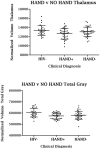Association between brain volumes and HAND in cART-naïve HIV+ individuals from Thailand
- PMID: 25604494
- PMCID: PMC4375016
- DOI: 10.1007/s13365-014-0309-8
Association between brain volumes and HAND in cART-naïve HIV+ individuals from Thailand
Abstract
This study aimed to determine the effects of human immunodeficiency virus (HIV) on brain structure in HIV-infected individuals with and without HIV-associated neurocognitive disorders (HAND). Twenty-nine HIV-uninfected controls, 37 HIV+, treatment-naïve, individuals with HAND (HIV+HAND+; 16 asymptomatic neurocognitive impairment (ANI), 12 mild neurocognitive disorder (MND), and 9 HIV-associated dementia HAD), and 37 HIV+, treatment-naïve, individuals with normal cognitive function (HIV+HAND-) underwent magnetic resonance imaging (MRI) and neuropsychological assessment. The HIV-infected participants had a mean (SD) age of 35 (7) years, mean (interquartile range (IQR)) CD4 count of 221 (83-324), and mean (IQR) log10 plasma viral load of 4.81 (4.39-5.48). Six regions of interest were selected for analyses including total and subcortical gray matter, total white matter, caudate, corpus callosum, and thalamus. The HIV+/HAND+ group exhibited significantly smaller brain volumes compared to the HIV-uninfected group in subcortical gray and total gray matter; however, there were no statistically significant differences in brain volumes between the HIV+HAND+ and HIV+HAND- groups or between HIV+/HAND- and controls. CD4 count at time of combination antiretroviral therapy (cART) initiation was associated with total and subcortical gray matter volumes but not with cognitive measures. Plasma viral load correlated with neuropsychological performance but not brain volumes. The lack of significant differences in brain volumes between HIV+HAND+ and HIV+HAND- suggests that brain atrophy is not a sensitive measure of HAND in subjects without advanced immunosuppression. Alternatively, current HAND diagnostic criteria may not sufficiently distinguish patients based on MRI measures of brain volumes.
Figures




References
-
- Wirachsilp P, Kantakamalakul W, Foongladda S, Chuenchitra T, Kohriangudom S, Athipanyasilp N, Sutthent R. Surveillance of subtype and genetic variation of the circulating strains of HIV-1 in Thailand. Southeast Asian J Trop Med Public Health. 2007;38:814–827. - PubMed
-
- Ranjbar S, Rajsbaum R, Goldfeld AE. Transactivator of transcription from HIV type 1 subtype E selectively inhibits TNF gene expression via interference with chromatin remodeling of the TNF locus. The Journal of Immunology. 2006;176(7):4182–4190. - PubMed
Publication types
MeSH terms
Grants and funding
LinkOut - more resources
Full Text Sources
Other Literature Sources
Research Materials

